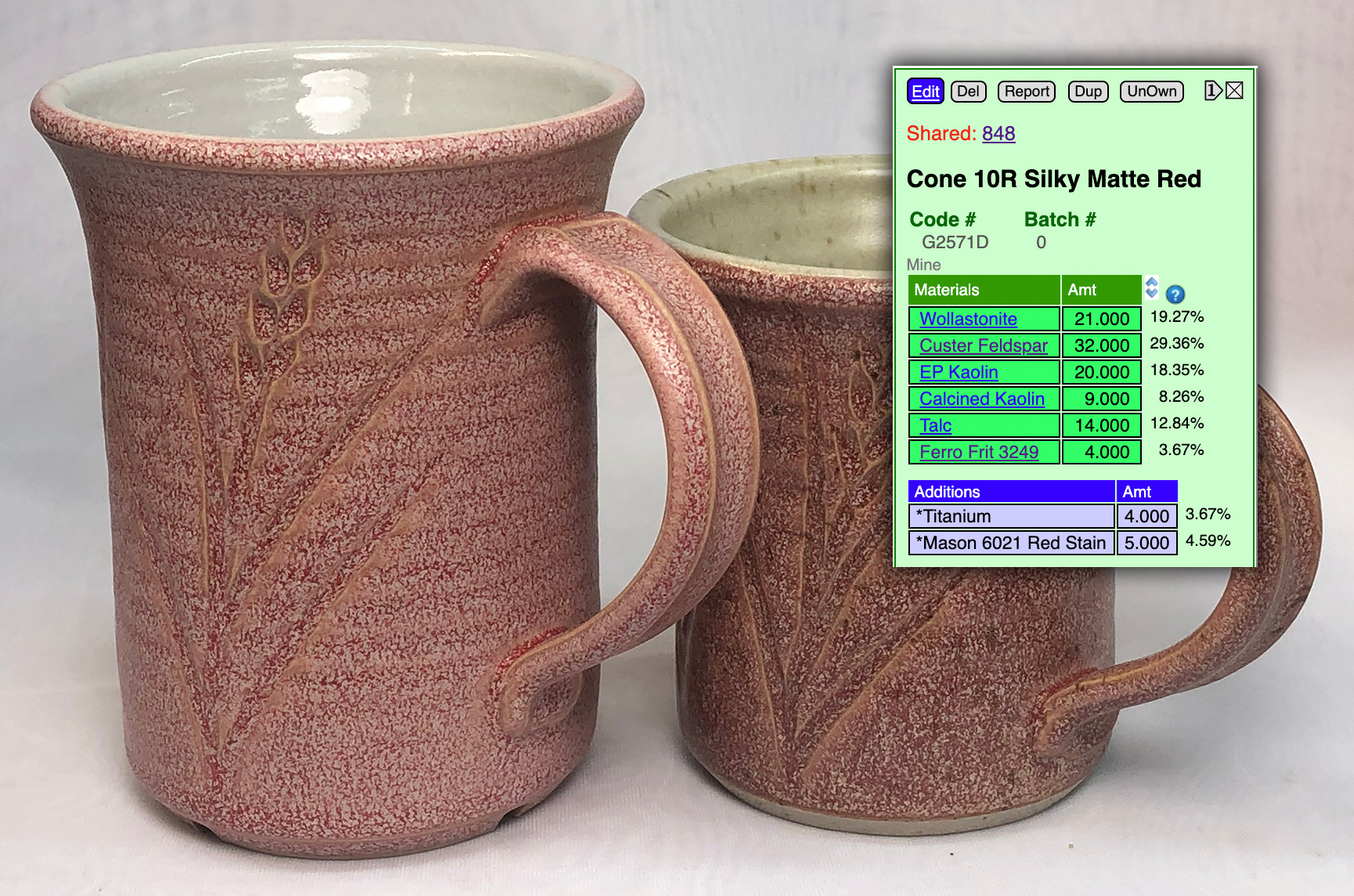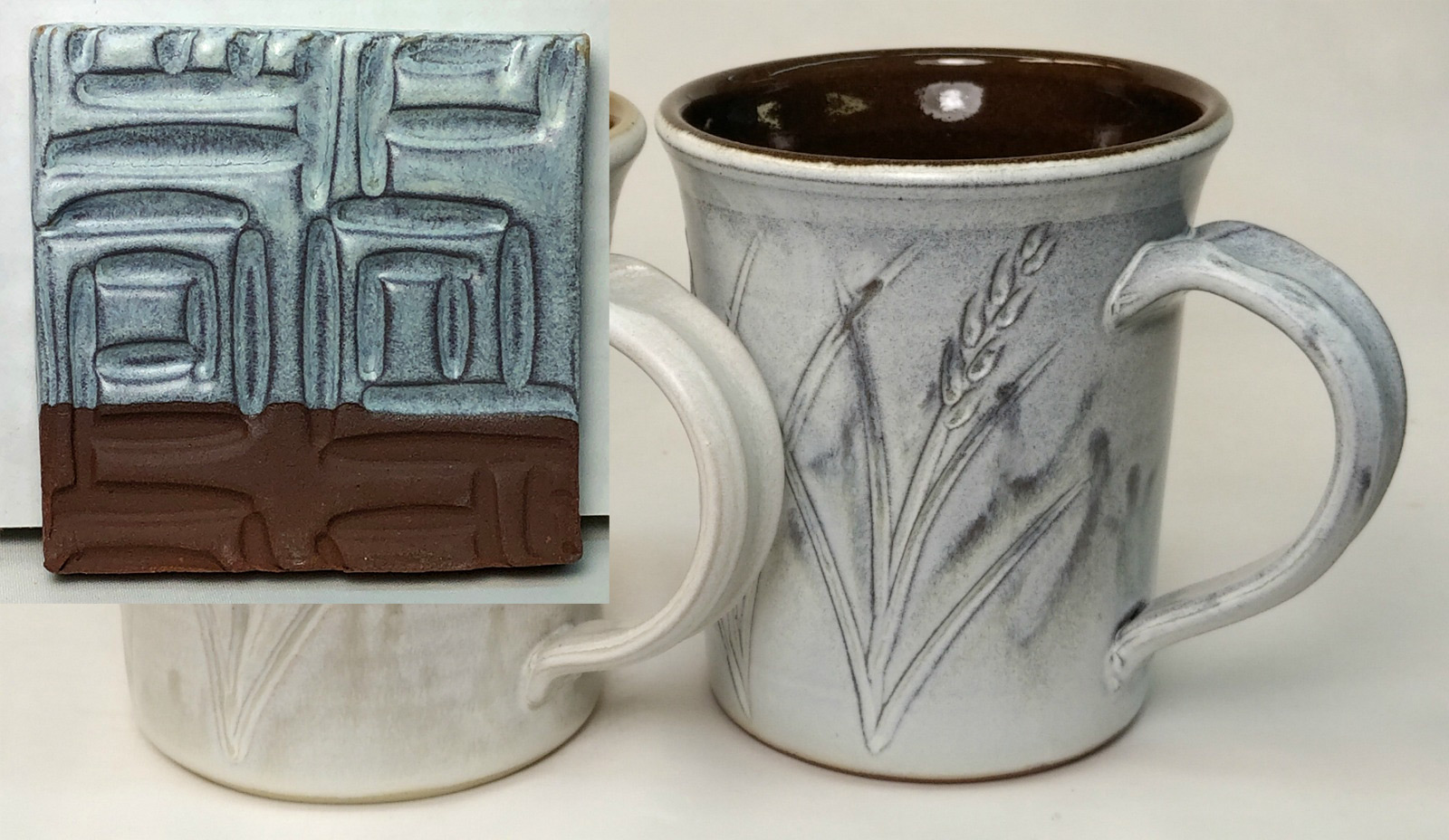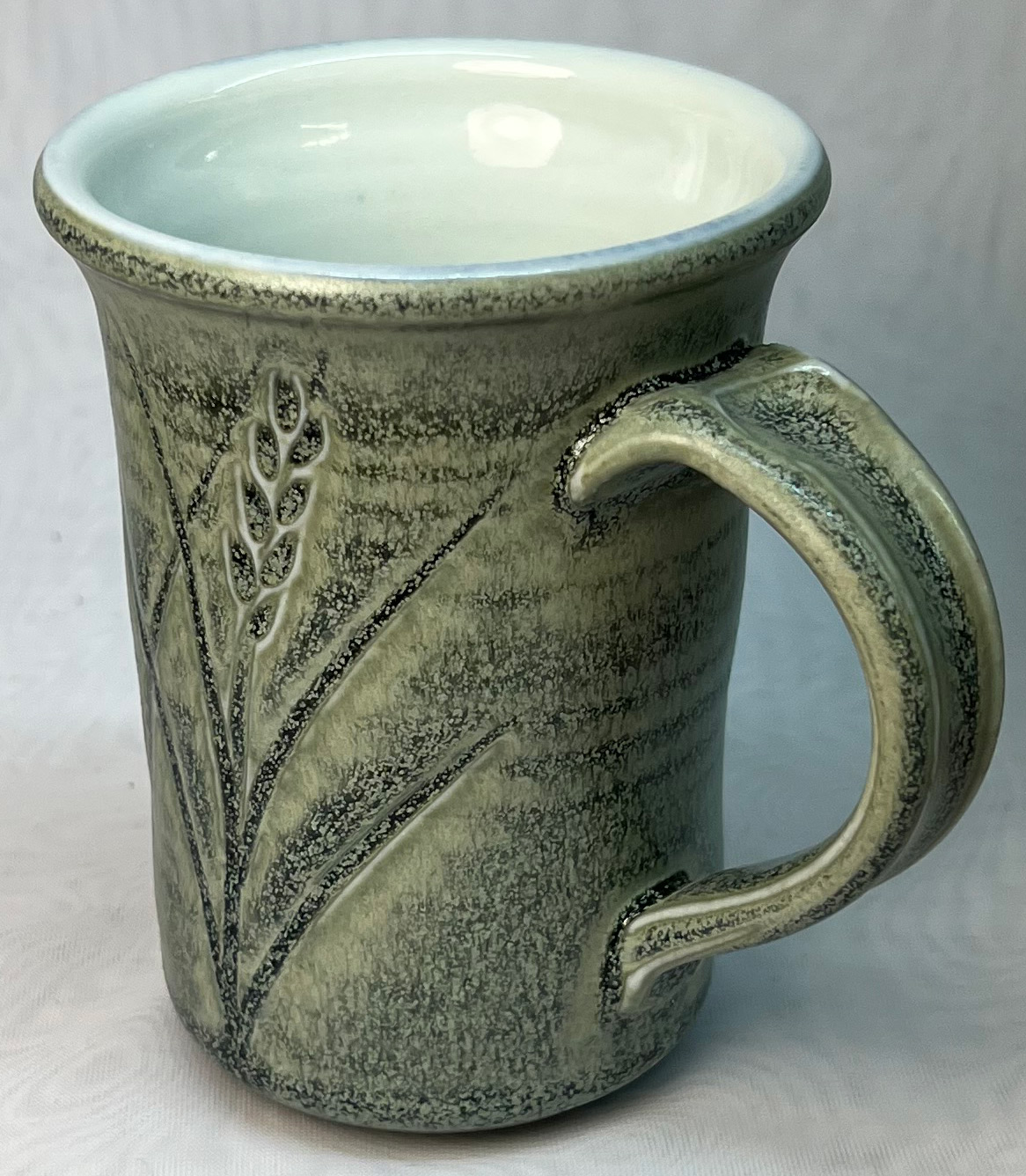| Monthly Tech-Tip | No tracking! No ads! | |
Titanium Dioxide
Alternate Names: TiO2
Description: Anatase, Brookite
| Oxide | Analysis | Formula | Tolerance |
|---|---|---|---|
| TiO2 | 100.00% | 1.00 | |
| Oxide Weight | 79.90 | ||
| Formula Weight | 79.90 | ||
Notes
TiO2 occurs in many silicates in nature, accounting for over 1% of the earth's crust. Thus it is manufactured using a variety of materials and processes. Titanium dioxide power is very fine-grained and it agglomerates, so glazes containing it need to be sieved to break down the small lumps (even a high-speed propeller mixer often won't do it).
Although titanium is the strongest white pigment known for many uses, in ceramics the whiteness (and opacity) it imparts to glazes is due to its tendency to crystallize during cooling. While titanium dioxide is used in glazes as an opacifier, it is not as effective and easy to use as tin oxide or zircon. It can be used as an additive to enliven (variegate, crystallize) the color and texture of glazes by introducing crystallization. Rutile works in a similar manner, typically both become saturated in the melt beyond about 5-6%, producing a dry and unstable glaze surface. In moderate amounts, it encourages strong melts, durable surfaces and rich visual textures.
Titanium is available both as raw and surface-treated products. Non-pigmentary grades flow more freely in the dry state. Self-opacified enamels are made by adding titanium during smelting to supersaturation. Upon firing the enamel, the titanium crystallizes or precipitates to produce the opacity. Titania is also used in dry process enameling on cast iron appliances for its effect on acid resistance, color and texture. In glass, non-pigmentary titanium dioxide increases the refractive index and intensifies color.
Related Information
Original Container Bag of Titanium Dioxide

This picture has its own page with more detail, click here to see it.
Variegating effect of sprayed-on layer of titanium dioxide

This picture has its own page with more detail, click here to see it.
The base glaze (inside and out) is GA6-D Alberta Slip glaze fired at cone 6 on a buff stoneware. However, on the outside, the dried-on glaze was over-sprayed with a very thin layer of titanium and water (VeeGum can be used to help gel the sprayable titanium slurry and suspend it). The dramatic effect is a real testament to the variegating power of TiO2. An advantage of this technique is the source: Titanium dioxide. It is a more consistent source of TiO2 than the often-troublesome rutile. Another advantage is that the variegation can be selectively applied in specific areas or as a design. This effect should work on most glossy glazes having adequate melt fluidity.
Thin titanium band sprayed over cone 6 glazes demonstrates crystallization

This picture has its own page with more detail, click here to see it.
The first is on GA6-A, the rest are on GA6-C (Alberta slip glazes). The last has been applied too thickly, the brown band is dry and blistered.
Titanium as an opacifier

This picture has its own page with more detail, click here to see it.
This is a lithium glaze fired at cone 6. It has 6% titanium. This effect will also work in other types of transparent recipes. There should be more blue with slower cooling. Mixing some rutile in (e.g. 4 titanium, 2 rutile) should enhance also. 6% is pushing the edge of how much titanium should be in a recipe. Any more, or cooling too slow, could transform the surface into a mass of white crystals (which would be rough and non-functional). It is best to manually program firings, the up and down schedules? That would make the result consistent no matter how heavily or lightly loaded a kiln is.
Titanium Dioxide in a cone 6 calcium matte glaze

This picture has its own page with more detail, click here to see it.
The glaze is G1214Z1 cone 6 base calcium matte on Plainsman M390 fired at cone 6 using the PLC6DS schedule. 5% titanium dioxide has been added. Titanium can create reactive glazes, like rutile, with no other colorants added. This effect also works well on matte surfaces, but the glaze needs good melt fluidity (that is good because functional mattes melt well). Calcium mattes host crystallization and work particularly well. Because titanium dioxide does not contain iron oxide lighter colors and better blues are possible compared to rutile (iron is still needed by it is coming from the body here). Like rutile, the effects are dependent on the cooling rate of the firing, slower cools produce more reactivity. Even application without drips is important (mixing as a thixotropic dipping glaze is best). This appearance also depends on using dark burning body or engobe.
The titanium/stain mechanism at cone 10R

This picture has its own page with more detail, click here to see it.
These are porcelain and stoneware mugs. The glaze is G2571D (based on the fritted G2571B version of G2571A). This project started with calculations to source boron from a frit (instead of Gerstley Borate), MgO from talc and a frit (instead of dolomite). These moves enabled eliminating raw silica from the recipe. This produced a finer silky texture and better melt fluidity (for hosting colors). Adding rutile and zircopax produced a great bamboo. But what about variegating using titanium instead of rutile (it contains no iron so colors should be brighter)? Jackpot with this red stain! The titanium has done it's job even a little too well. Cobalt and titanium also worked.
A titanium/colorant addition to a cone 10 magnesia matte glaze

This picture has its own page with more detail, click here to see it.
These porcelain mugs have the same glaze, the one on the left was fired at cone 10R (gas), the other at cone 10 oxidation (electric). This is our standard cone 10R magnesia matte, G2571B. We have added a 5% Mason 6021 encapsulated red stain and 4% titanium dioxide (producing recipe code number G2571D). While the reduction version looked good the oxidation one turned out much more vibrant. And it feels much better, being very pleasant to touch. The marbling is a bit excessive so in G2571D1 we reduced the titanium by 1% (and increased the stain by 1%). MgO matte base recipes are very receptive to this type of adjustment and they work across a wide range (from low to high temperatures). Titanium is much better for variegating bright colored glazes than rutile, because the latter contains lots of iron that muddies the color.
A titanium/colorant addition to a cone 6 magnesia matte glaze

This picture has its own page with more detail, click here to see it.
This is the G3939A recipe (a 90:10 mix of G2934 and G2926B), it normally produces a silky matte if not cooled too quickly. Shown on the left is our original addition of 8% Mason 6021 red stain and 4.5% titanium dioxide. This not only did not produce the desired marbled effect, it actually made it more glossy! A 1.5% titanium addition completely transforms it to what you see on the right. Rutile, as a source of TiO2, is often used for this, but it is high in iron and would completely muddy the red color. Pure titanium dioxide, by contrast, is iron free.
Titanium instead of rutile for floating blue

This picture has its own page with more detail, click here to see it.
Rutile blue glazes are actually titanium blues (because rutile mineral is an impure source of TiO2 and Fe2O3). The iron and titanium in the rutile react to form the floating blue effect. The GA6-C recipe has always relied on a 4% rutile addition. Its GA6-A base recipe contains significant iron (because of the 80% Alberta Slip), so could titanium oxide deliver the same floating blue effect? Yes.
These mugs are M390 clay. The top left one is the standard GA6-C (with rutile) fired using the C6DHSC slow-cool firing schedule (the bottom left normal cool PLC6DS schedule produces little color). But the ones on the right switch the 4% rutile for titanium dioxide (the L4655 recipe). The top right was fired using the slow cool, the bottom right was the normal cool schedule.
Titanium thus seems more consistent and reliable material than rutile. An excellent blue color is produced even without a slow cool (lower right).
Same glaze, same firing - titanium accounts for the difference

This picture has its own page with more detail, click here to see it.
The glaze is L4655 fired at cone 6 using the C6DHSC firing schedule (the glaze is Alberta Slip with a frit addition and 4% titanium dioxide). These mugs were in the same firing. On the porcelain (left) the glaze fires the expected floating blue. The degree of difference on the right has two contributing apparent factors. While other clay bodies of similar color do not affect this glaze as much, the body used in the mug on the right contains Plainsman 3B, at cone 6 it vitrifies (releasing iron compounds) and it releases iron in soluble salts that are interacting with the glaze. Titanium is very sensitive to the presence of iron and this body is making it available in an effective form. The difference would be much less if rutile had been used, since it already contains significant iron.
Zircopax, tin oxide, titanium as opacifiers in four base glazes

This picture has its own page with more detail, click here to see it.
The body is Plainsman M390. Firing is the cone 6 PLC6DS schedule. Each horizontal row is a commonly-used base glaze. The top one is an MgO matte, the next one down is a calcium matte, row 3 is G2926B glossy and row 4 is Ravenscrag Slip+frit. The two mattes behave very differently from each other with the additions of opacifier. Thickly applying an opacified glaze will obviously affect visual character (column 4). Tin oxide fires whiter than zircon (e.g. Zircopax). If you like the G2934 recipe, consider the G2934Y variant for better melting.
A hazard of using titanium opacifier in a glaze

This picture has its own page with more detail, click here to see it.
On a clay test tile this titanium opacified cone 6 oxidation glaze, G1214Z1, looks great. But it is important to recognize that its variegated fired appearance is a combination multiple factors: The chemistry of the glaze, the titanium, quality laydown, the PLC6DS firing schedule, the red M390 clay body and variations in the thickness-of-application. However, the last four of those factors changed with the mug on the right! It is made from buff-burning M340! There are drips from uneven drainage during glazing. The slow cool C6DHSC firing schedule. Notice how it is actually going transparent where very thick. An even laydown was not achieved since the slurry was not properly mixed, it contains calcined kaolin and requires special attention to achieve a thixotropy.
G2571C rutile blue on P700 at cone 10R

This picture has its own page with more detail, click here to see it.
The clay body is Plainsman P700. This was fired in cone 10R using the C10RPL firing schedule. The outside glaze is G2571C. The inside glaze is G1947U.
The surprising results of titanium/talc additions to Ravenscrag slip at cone 10R

This picture has its own page with more detail, click here to see it.
Talc additions to RCS produce variegated silky matte surfaces (in 10-15% amounts) at cone 10R. What if titanium is also added? This triaxial blend shows what works.
Top tile #1: Pure Ravenscrag Slip (RCS)
Bottom left tile #7: 85% RCS, 15% Talc.
Bottom right tile #10: 95% RCS, 5% Titanium Dioxide. The addition of a little titanium further improves the effect as shown on #8 (88% RCS, 10% Talc, 2% Titanium) and #6 (90% RCS, 10% Talc, 3.5% Titanium). But too much titanium loses it (tile #9) and adding only titanium goes glossy brown. This shows that some TiO2 is good, too much and the effect is lost.
Links
| URLs |
http://www.inminex.com/
Interesting deposit in South America |
| URLs |
http://en.wikipedia.org/wiki/Titanium_Dioxide
Titanium dioxide at Wikipedia |
| Hazards |
Titanium Dioxide Toxicology
|
| Typecodes |
Generic Material
Generic materials are those with no brand name. Normally they are theoretical, the chemistry portrays what a specimen would be if it had no contamination. Generic materials are helpful in educational situations where students need to study material theory (later they graduate to dealing with real world materials). They are also helpful where the chemistry of an actual material is not known. Often the accuracy of calculations is sufficient using generic materials. |
| Typecodes |
Opacifier
Opacifiers are powders that turn transparent glazes opaque by various chemical and physical mechanisms (and combinations of mechanisms). |
| Materials |
Rutile
A raw TiO2-containing mineral used in ceramics to color and variegate glaze surfaces. |
| Glossary |
Opacifier
Glaze opacity refers to the degree to which it is opaque. Opacifiers are powders added to transparent ceramic glazes to make them opaque. |
| Oxides | TiO2 - Titanium Dioxide, Titania |
| Minerals |
Anatase
A mineral form of titanium dioxide. |
| Minerals |
Brookite
A mineral form on titanium dioxide. |
| Minerals |
Rutile
Rutile is the mineral name for natural crystals of titanium dioxide. It is a very hard (6-6.5 Moh) a |
Data
| Hardness (Moh) | 6.5 |
|---|---|
| Frit Softening Point | 1830C |
| Density (Specific Gravity) | 4.26 |
Mechanisms
| Glaze Crystallization | TiO2 dissolves into the melt during firing but normally re-crystallizes (or acts as a crystallization catalyst) during cooling (with rutile structure). |
|---|---|
| Glaze Matteness | Titanium can be used in glazes to produce a matte surface with increasing amounts of crystallization in amounts up to 25%. The effect works in most stoneware glazes and is better when the glaze is slow cooled. |
| Glaze Opacifier | Titanium is a crystalline mineral and encourages crystal development during cooling and freezing of the glaze melt. This generally produces opacity. However, titanium opacified glazes have a much different character than zircon or tin types. The latter produces a much more even and bright white coloration. When used as an opacifier the batch amount can range to 10% or more of the recipe. |
| Glaze Variegation | Smaller amounts of titanium dioxide (i.e. 5%) added to colored or opacified recipes can variegate the surface and make it more interesting (e.g. it alters the shape of crystals, shade of colors). |
| By Tony Hansen Follow me on        |  |
Got a Question?
Buy me a coffee and we can talk

https://digitalfire.com, All Rights Reserved
Privacy Policy
